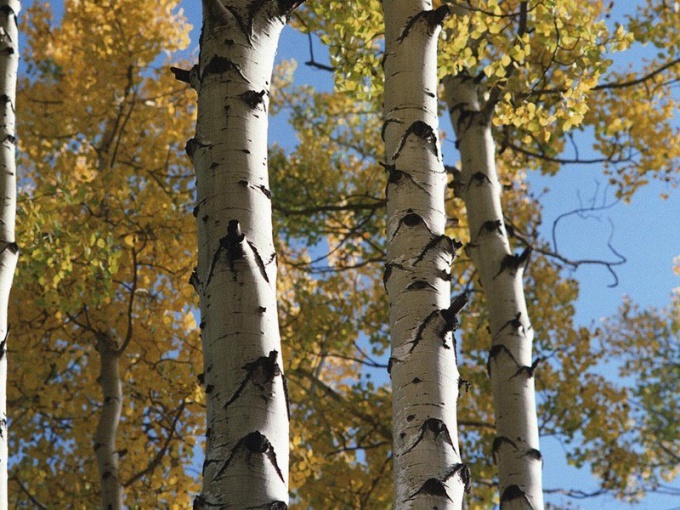The appearance of aspen
Aspen allocates a columnar trunk that can reach a length of 35 m and diameter 1 m. Decorative forms are pyramidal and weeping crown. The characteristic feature of this tree is smooth, the bark light green or light gray. Closer to the roots with age, it darkens and cracks. The wood of the aspen is white with a slight greenish tinge. In the dark of the bark of aspen can be confused with birch, although if it is touched, the difference from the bark are noticeable. The bark of birch is characterized by a roughness.
In the winter, due to the lack of foliage, aspen can be confused with poplar. You can distinguish them, perhaps, only by location. So, in poplar forests usually are not found, and in the city, on the contrary, seldom grows aspen. A more reliable difference are the kidneys. At poplar they are longer.
In the summer, aspen can confidently recognize. They have it round or oval shape with irregular notched edges, a length of 3-7 cm From coppice shoots the leaves usually are large in size: their length reaches 15 cm. they are almost heart-shaped.
The venation of the leaves of aspen Cirrus. They are smooth on both sides, but the exterior are a dark green color, and lower - light-gray-green. With the advent of autumn, the foliage turns a variety of colors - from gold to crimson.
The location of the branches and leaves of aspen ordinary. It is noteworthy that the leaves on this tree exciting tremble even at the slightest breeze. All because of their special structure. Aspen leaves have long stalks, which are flattened, while in the middle they are thinner. Meanwhile, there is the idiom "to tremble like an aspen leaf", which means "to shake from fear.
Aspen is a dioecious plant. Its flowers are inconspicuous, small, clustered in drooping catkins. The flowers on the male tree have a reddish color and length up to 15 cm Female catkins are greenish and a little thinner. Aspen blooms before leaves.
Where aspen is growing
Aspen feels good on different soils. It grows in forest-steppe and forest zones. It can be seen in forests, along rivers, forest edges, clearings and occasionally on dry Sands, marshes, ravines and mountains.
Often it forms Osinniki and is part of the mixed forests in company with deciduous and conifers. Usually near aspen you can see pine, larch, birch, alder. Aspen can survive forest fires, because its roots are located deep underground.
